Financial Accounting and Analysis: Tesco vs. Morrison Report
VerifiedAdded on 2023/01/12
|12
|3285
|44
Report
AI Summary
This report presents a financial analysis of Tesco and Wm Morrison, two major retail companies in the UK. The introduction defines financial analysis and its importance in evaluating business performance. Part 1 provides an overview of Tesco and Morrison, including their business models and market positions. Part 2 focuses on a comparative financial analysis using various ratios, including liquidity, profitability, efficiency, and debt-equity ratios, to assess their financial health. The analysis covers aspects like current ratio, quick ratio, net profit margin, gross profit margin, return on equity, inventory days, debtor’s collection period, creditors’ payable period, asset turnover ratio, and debt-equity ratio. Part 3 highlights sustainability disclosures made by both firms. The report concludes with a summary of the findings and provides references. The report includes an appendix with supporting data and calculations. The coursework was submitted for the Financial Accounting & Analysis module in 2019/2020.

Financial accounting and
analysis
analysis
Paraphrase This Document
Need a fresh take? Get an instant paraphrase of this document with our AI Paraphraser
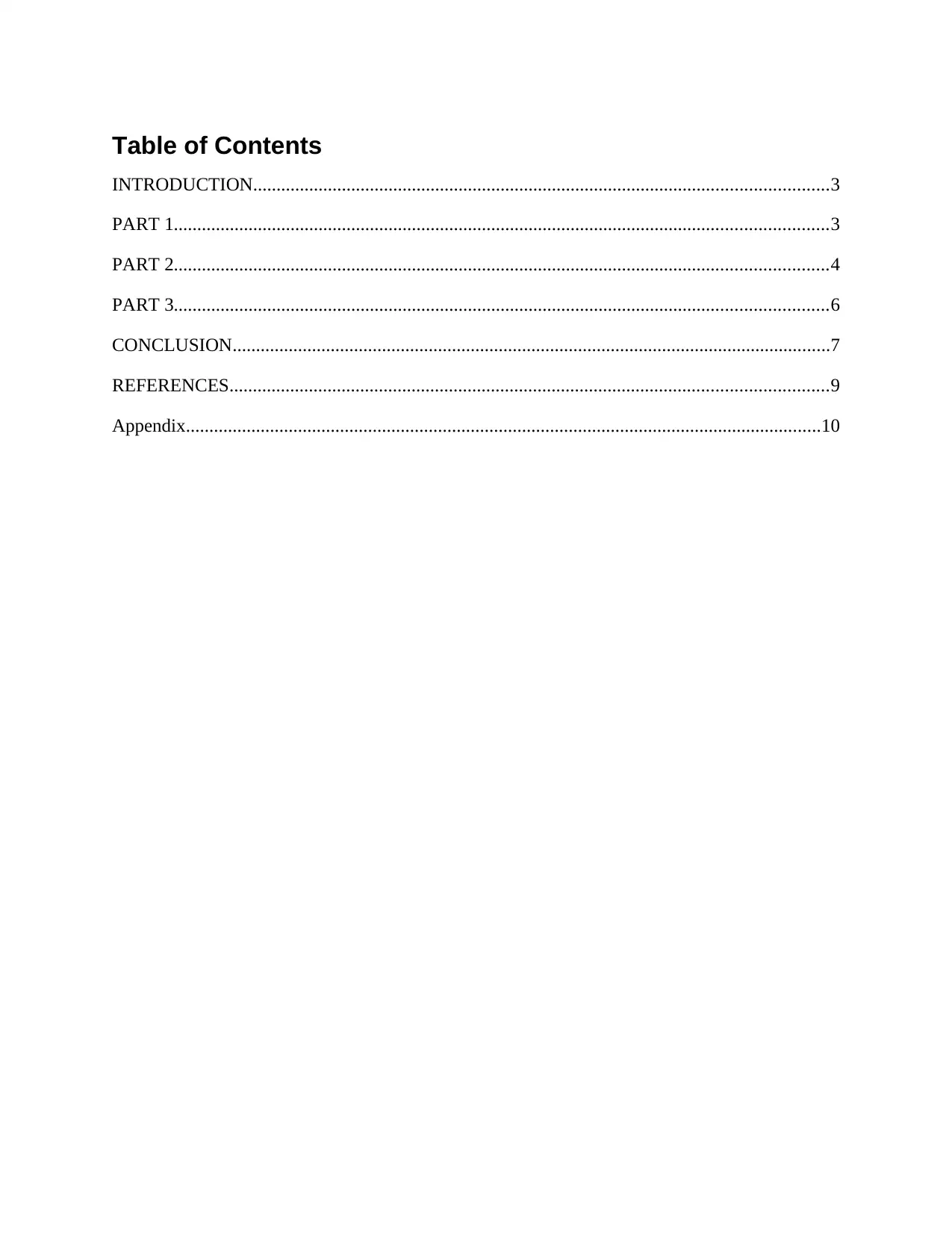
Table of Contents
INTRODUCTION...........................................................................................................................3
PART 1............................................................................................................................................3
PART 2............................................................................................................................................4
PART 3............................................................................................................................................6
CONCLUSION................................................................................................................................7
REFERENCES................................................................................................................................9
Appendix........................................................................................................................................10
INTRODUCTION...........................................................................................................................3
PART 1............................................................................................................................................3
PART 2............................................................................................................................................4
PART 3............................................................................................................................................6
CONCLUSION................................................................................................................................7
REFERENCES................................................................................................................................9
Appendix........................................................................................................................................10

INTRODUCTION
Financial analysis is the practice of evaluating budgets, businesses, proposals and the
other finance relating transactions for determining their suitability and the performance. It is
been used for assessing stability, liquidity, profitability and solvency of the company which is
sufficient for warranting monetary investment. The present report is based on Tesco and
Morrison, retail sector companies stated as largest supermarket chain and grocery retailers in
UK. Furthermore, the report presents an overview of the companies and financial analysis by
using ratio analysis as a tool in order to make comparative assessment. Moreover, the study
highlights sustainability disclosures made by both the firms.
PART 1
Tesco is counted as one of the leading retail organization and is ranked as third largest
grocery retailer with the outlets within an entire UK. The company head began its business in the
year 1919 with a single man named as Jack Cohen, selling the groceries from the stall in the East
End of the London. The corporation has expanded its business since then by combination of
acquiring retail services, new stores and by way of adapting the needs and the preferences of the
customers. The main or foremost objective is serving customers with best quality products and
the services. Keeping an existing customer as happy seems as very important for an enterprise
because it is more cost effective for an entity as compared to acquiring the new ones. In UK
Company have around 2200 stores that ranges from extra large hypermarket type of stores to the
small express high street kind of outlets (Annual report of Tesco, 2018). Moreover, Original
product of Tesco in terms of grocery and the general merchandise items has been diversified for
including insurance, banking, electrical goods, telephone equipment etc. Tesco has expanded its
customer base by going on to the online channel through its website Tesco.com which had
attracted millions of the users towards the brand. Tesco announced for sales higher than £ 1
billion in a week and gained higher profits greater than £ 3.4 billion in a year in the year of 2010,
despite an effect of global downturn.
Wm Morrison is engaged in an operation of the retail supermarket outlets under a brand
of Morrison’s and attached activities. The brand of the company includes Nutmeg, Naturally
Wonky, Home Cook, Free From and V taste an. The firm is also having food producing
capabilities in respect of fish, fruit, bakery, meat, deli and the flowers. The company was
established in year 1899 in Bradford by William Morrison and took over by Sir Ken Morrison.
He taken over entire operations and enhanced performance of the company in becoming as
fourth largest or leading competitor in UK. Currently, supermarket industry has capture higher
than 15% of the market share in grocery market within UK (Annual report of Morrison, 2018).
The company started as the seller of bread-butter from stall to the counter sells in year 1960 and
created a first supermarket in the year 1961 in the Victoria City, Bradford. After getting listed on
the FTSE 100, an entity had made a continuous growth & expanded their respective branches
Financial analysis is the practice of evaluating budgets, businesses, proposals and the
other finance relating transactions for determining their suitability and the performance. It is
been used for assessing stability, liquidity, profitability and solvency of the company which is
sufficient for warranting monetary investment. The present report is based on Tesco and
Morrison, retail sector companies stated as largest supermarket chain and grocery retailers in
UK. Furthermore, the report presents an overview of the companies and financial analysis by
using ratio analysis as a tool in order to make comparative assessment. Moreover, the study
highlights sustainability disclosures made by both the firms.
PART 1
Tesco is counted as one of the leading retail organization and is ranked as third largest
grocery retailer with the outlets within an entire UK. The company head began its business in the
year 1919 with a single man named as Jack Cohen, selling the groceries from the stall in the East
End of the London. The corporation has expanded its business since then by combination of
acquiring retail services, new stores and by way of adapting the needs and the preferences of the
customers. The main or foremost objective is serving customers with best quality products and
the services. Keeping an existing customer as happy seems as very important for an enterprise
because it is more cost effective for an entity as compared to acquiring the new ones. In UK
Company have around 2200 stores that ranges from extra large hypermarket type of stores to the
small express high street kind of outlets (Annual report of Tesco, 2018). Moreover, Original
product of Tesco in terms of grocery and the general merchandise items has been diversified for
including insurance, banking, electrical goods, telephone equipment etc. Tesco has expanded its
customer base by going on to the online channel through its website Tesco.com which had
attracted millions of the users towards the brand. Tesco announced for sales higher than £ 1
billion in a week and gained higher profits greater than £ 3.4 billion in a year in the year of 2010,
despite an effect of global downturn.
Wm Morrison is engaged in an operation of the retail supermarket outlets under a brand
of Morrison’s and attached activities. The brand of the company includes Nutmeg, Naturally
Wonky, Home Cook, Free From and V taste an. The firm is also having food producing
capabilities in respect of fish, fruit, bakery, meat, deli and the flowers. The company was
established in year 1899 in Bradford by William Morrison and took over by Sir Ken Morrison.
He taken over entire operations and enhanced performance of the company in becoming as
fourth largest or leading competitor in UK. Currently, supermarket industry has capture higher
than 15% of the market share in grocery market within UK (Annual report of Morrison, 2018).
The company started as the seller of bread-butter from stall to the counter sells in year 1960 and
created a first supermarket in the year 1961 in the Victoria City, Bradford. After getting listed on
the FTSE 100, an entity had made a continuous growth & expanded their respective branches
⊘ This is a preview!⊘
Do you want full access?
Subscribe today to unlock all pages.

Trusted by 1+ million students worldwide
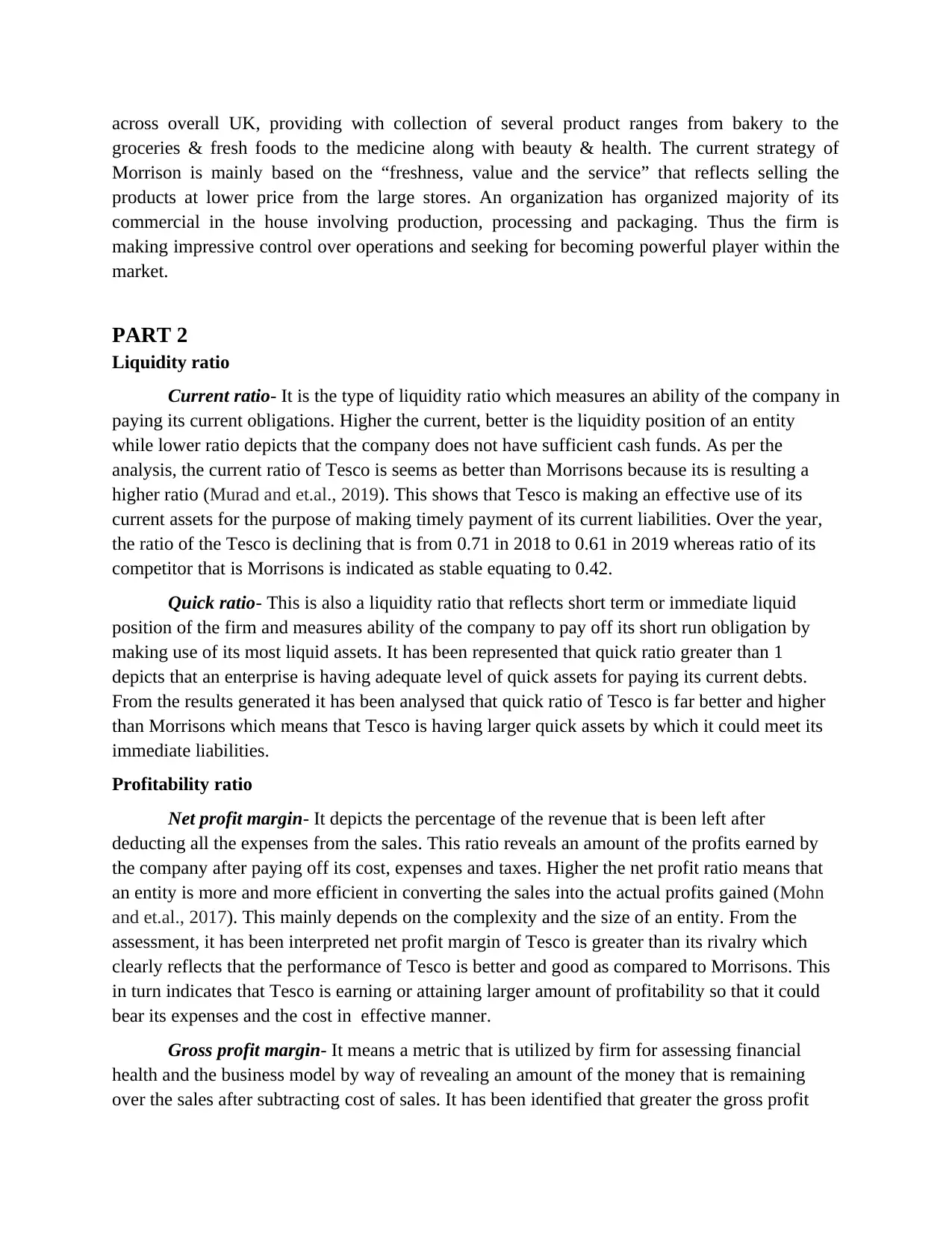
across overall UK, providing with collection of several product ranges from bakery to the
groceries & fresh foods to the medicine along with beauty & health. The current strategy of
Morrison is mainly based on the “freshness, value and the service” that reflects selling the
products at lower price from the large stores. An organization has organized majority of its
commercial in the house involving production, processing and packaging. Thus the firm is
making impressive control over operations and seeking for becoming powerful player within the
market.
PART 2
Liquidity ratio
Current ratio- It is the type of liquidity ratio which measures an ability of the company in
paying its current obligations. Higher the current, better is the liquidity position of an entity
while lower ratio depicts that the company does not have sufficient cash funds. As per the
analysis, the current ratio of Tesco is seems as better than Morrisons because its is resulting a
higher ratio (Murad and et.al., 2019). This shows that Tesco is making an effective use of its
current assets for the purpose of making timely payment of its current liabilities. Over the year,
the ratio of the Tesco is declining that is from 0.71 in 2018 to 0.61 in 2019 whereas ratio of its
competitor that is Morrisons is indicated as stable equating to 0.42.
Quick ratio- This is also a liquidity ratio that reflects short term or immediate liquid
position of the firm and measures ability of the company to pay off its short run obligation by
making use of its most liquid assets. It has been represented that quick ratio greater than 1
depicts that an enterprise is having adequate level of quick assets for paying its current debts.
From the results generated it has been analysed that quick ratio of Tesco is far better and higher
than Morrisons which means that Tesco is having larger quick assets by which it could meet its
immediate liabilities.
Profitability ratio
Net profit margin- It depicts the percentage of the revenue that is been left after
deducting all the expenses from the sales. This ratio reveals an amount of the profits earned by
the company after paying off its cost, expenses and taxes. Higher the net profit ratio means that
an entity is more and more efficient in converting the sales into the actual profits gained (Mohn
and et.al., 2017). This mainly depends on the complexity and the size of an entity. From the
assessment, it has been interpreted net profit margin of Tesco is greater than its rivalry which
clearly reflects that the performance of Tesco is better and good as compared to Morrisons. This
in turn indicates that Tesco is earning or attaining larger amount of profitability so that it could
bear its expenses and the cost in effective manner.
Gross profit margin- It means a metric that is utilized by firm for assessing financial
health and the business model by way of revealing an amount of the money that is remaining
over the sales after subtracting cost of sales. It has been identified that greater the gross profit
groceries & fresh foods to the medicine along with beauty & health. The current strategy of
Morrison is mainly based on the “freshness, value and the service” that reflects selling the
products at lower price from the large stores. An organization has organized majority of its
commercial in the house involving production, processing and packaging. Thus the firm is
making impressive control over operations and seeking for becoming powerful player within the
market.
PART 2
Liquidity ratio
Current ratio- It is the type of liquidity ratio which measures an ability of the company in
paying its current obligations. Higher the current, better is the liquidity position of an entity
while lower ratio depicts that the company does not have sufficient cash funds. As per the
analysis, the current ratio of Tesco is seems as better than Morrisons because its is resulting a
higher ratio (Murad and et.al., 2019). This shows that Tesco is making an effective use of its
current assets for the purpose of making timely payment of its current liabilities. Over the year,
the ratio of the Tesco is declining that is from 0.71 in 2018 to 0.61 in 2019 whereas ratio of its
competitor that is Morrisons is indicated as stable equating to 0.42.
Quick ratio- This is also a liquidity ratio that reflects short term or immediate liquid
position of the firm and measures ability of the company to pay off its short run obligation by
making use of its most liquid assets. It has been represented that quick ratio greater than 1
depicts that an enterprise is having adequate level of quick assets for paying its current debts.
From the results generated it has been analysed that quick ratio of Tesco is far better and higher
than Morrisons which means that Tesco is having larger quick assets by which it could meet its
immediate liabilities.
Profitability ratio
Net profit margin- It depicts the percentage of the revenue that is been left after
deducting all the expenses from the sales. This ratio reveals an amount of the profits earned by
the company after paying off its cost, expenses and taxes. Higher the net profit ratio means that
an entity is more and more efficient in converting the sales into the actual profits gained (Mohn
and et.al., 2017). This mainly depends on the complexity and the size of an entity. From the
assessment, it has been interpreted net profit margin of Tesco is greater than its rivalry which
clearly reflects that the performance of Tesco is better and good as compared to Morrisons. This
in turn indicates that Tesco is earning or attaining larger amount of profitability so that it could
bear its expenses and the cost in effective manner.
Gross profit margin- It means a metric that is utilized by firm for assessing financial
health and the business model by way of revealing an amount of the money that is remaining
over the sales after subtracting cost of sales. It has been identified that greater the gross profit
Paraphrase This Document
Need a fresh take? Get an instant paraphrase of this document with our AI Paraphraser
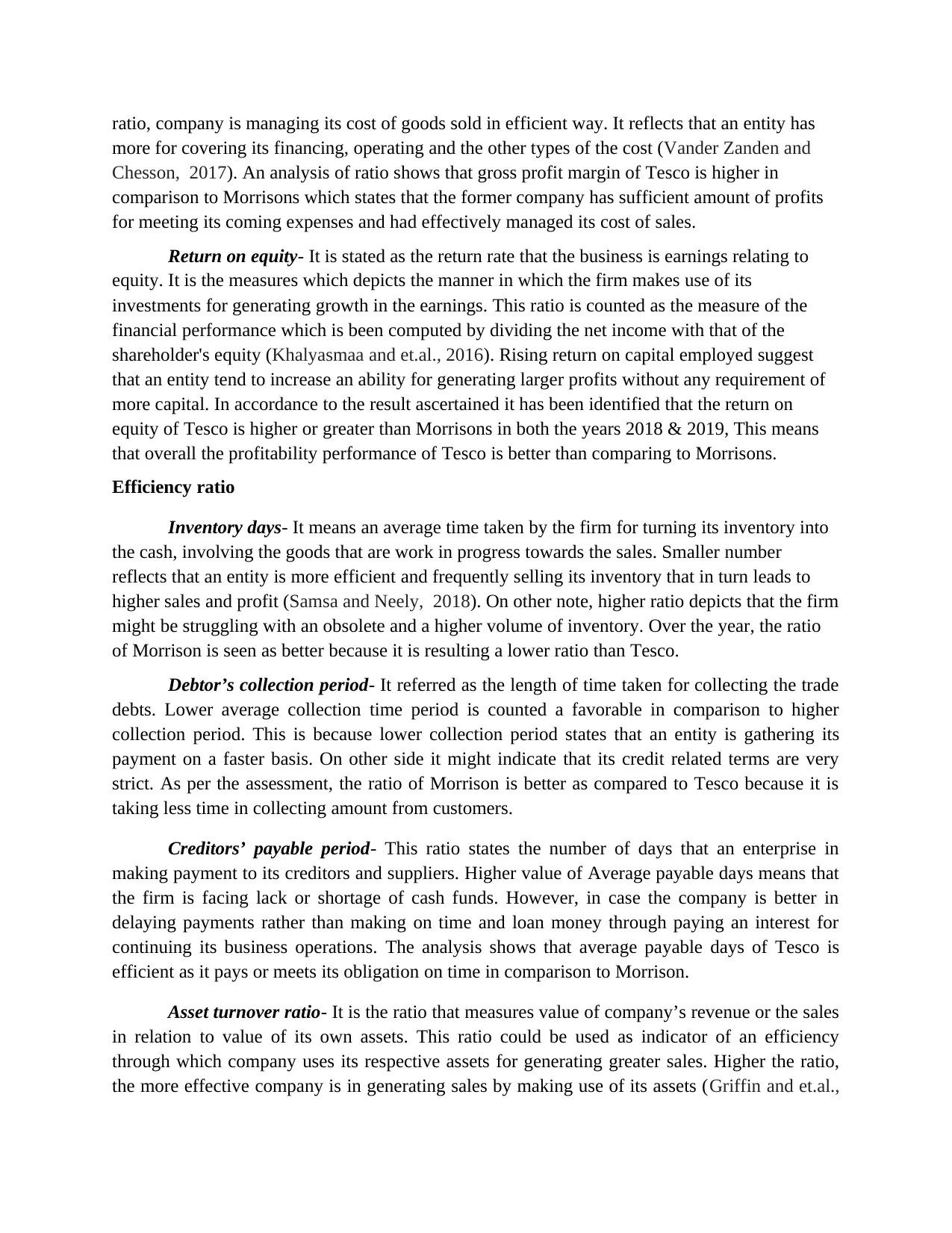
ratio, company is managing its cost of goods sold in efficient way. It reflects that an entity has
more for covering its financing, operating and the other types of the cost (Vander Zanden and
Chesson, 2017). An analysis of ratio shows that gross profit margin of Tesco is higher in
comparison to Morrisons which states that the former company has sufficient amount of profits
for meeting its coming expenses and had effectively managed its cost of sales.
Return on equity- It is stated as the return rate that the business is earnings relating to
equity. It is the measures which depicts the manner in which the firm makes use of its
investments for generating growth in the earnings. This ratio is counted as the measure of the
financial performance which is been computed by dividing the net income with that of the
shareholder's equity (Khalyasmaa and et.al., 2016). Rising return on capital employed suggest
that an entity tend to increase an ability for generating larger profits without any requirement of
more capital. In accordance to the result ascertained it has been identified that the return on
equity of Tesco is higher or greater than Morrisons in both the years 2018 & 2019, This means
that overall the profitability performance of Tesco is better than comparing to Morrisons.
Efficiency ratio
Inventory days- It means an average time taken by the firm for turning its inventory into
the cash, involving the goods that are work in progress towards the sales. Smaller number
reflects that an entity is more efficient and frequently selling its inventory that in turn leads to
higher sales and profit (Samsa and Neely, 2018). On other note, higher ratio depicts that the firm
might be struggling with an obsolete and a higher volume of inventory. Over the year, the ratio
of Morrison is seen as better because it is resulting a lower ratio than Tesco.
Debtor’s collection period- It referred as the length of time taken for collecting the trade
debts. Lower average collection time period is counted a favorable in comparison to higher
collection period. This is because lower collection period states that an entity is gathering its
payment on a faster basis. On other side it might indicate that its credit related terms are very
strict. As per the assessment, the ratio of Morrison is better as compared to Tesco because it is
taking less time in collecting amount from customers.
Creditors’ payable period- This ratio states the number of days that an enterprise in
making payment to its creditors and suppliers. Higher value of Average payable days means that
the firm is facing lack or shortage of cash funds. However, in case the company is better in
delaying payments rather than making on time and loan money through paying an interest for
continuing its business operations. The analysis shows that average payable days of Tesco is
efficient as it pays or meets its obligation on time in comparison to Morrison.
Asset turnover ratio- It is the ratio that measures value of company’s revenue or the sales
in relation to value of its own assets. This ratio could be used as indicator of an efficiency
through which company uses its respective assets for generating greater sales. Higher the ratio,
the more effective company is in generating sales by making use of its assets (Griffin and et.al.,
more for covering its financing, operating and the other types of the cost (Vander Zanden and
Chesson, 2017). An analysis of ratio shows that gross profit margin of Tesco is higher in
comparison to Morrisons which states that the former company has sufficient amount of profits
for meeting its coming expenses and had effectively managed its cost of sales.
Return on equity- It is stated as the return rate that the business is earnings relating to
equity. It is the measures which depicts the manner in which the firm makes use of its
investments for generating growth in the earnings. This ratio is counted as the measure of the
financial performance which is been computed by dividing the net income with that of the
shareholder's equity (Khalyasmaa and et.al., 2016). Rising return on capital employed suggest
that an entity tend to increase an ability for generating larger profits without any requirement of
more capital. In accordance to the result ascertained it has been identified that the return on
equity of Tesco is higher or greater than Morrisons in both the years 2018 & 2019, This means
that overall the profitability performance of Tesco is better than comparing to Morrisons.
Efficiency ratio
Inventory days- It means an average time taken by the firm for turning its inventory into
the cash, involving the goods that are work in progress towards the sales. Smaller number
reflects that an entity is more efficient and frequently selling its inventory that in turn leads to
higher sales and profit (Samsa and Neely, 2018). On other note, higher ratio depicts that the firm
might be struggling with an obsolete and a higher volume of inventory. Over the year, the ratio
of Morrison is seen as better because it is resulting a lower ratio than Tesco.
Debtor’s collection period- It referred as the length of time taken for collecting the trade
debts. Lower average collection time period is counted a favorable in comparison to higher
collection period. This is because lower collection period states that an entity is gathering its
payment on a faster basis. On other side it might indicate that its credit related terms are very
strict. As per the assessment, the ratio of Morrison is better as compared to Tesco because it is
taking less time in collecting amount from customers.
Creditors’ payable period- This ratio states the number of days that an enterprise in
making payment to its creditors and suppliers. Higher value of Average payable days means that
the firm is facing lack or shortage of cash funds. However, in case the company is better in
delaying payments rather than making on time and loan money through paying an interest for
continuing its business operations. The analysis shows that average payable days of Tesco is
efficient as it pays or meets its obligation on time in comparison to Morrison.
Asset turnover ratio- It is the ratio that measures value of company’s revenue or the sales
in relation to value of its own assets. This ratio could be used as indicator of an efficiency
through which company uses its respective assets for generating greater sales. Higher the ratio,
the more effective company is in generating sales by making use of its assets (Griffin and et.al.,

2016). On the other hand, lower the ratio, the company does not seem as efficient in using its
assets for resulting higher revenue. As Morrison is resulting a higher assets turnover ratio, it
means that the company is making an efficient use of its assets for gaining higher revenues than
its rivalry.
Debt equity ratio- This ratio is been used for evaluating financial leverage of the
company and is computed by dividing the total liabilities with that of its total equity. This ratio
measures degree or extent to which the firm is financing its respective operations by using debts
over the owner funds. It indicates an ability of the shareholders equity for covering all the
outstanding debts in event of business downturn. Lower debt equity ratio sees as better as it
reflects less financial risk whereas higher D/E ratio is associated with the high risk which means
that company is aggressive in financing its growth with that of debt. The ratio of Morrison is
better because its is resulting a lower ratio in comparison to Tesco. This reflects that leverage
position of Morrison is better than Tesco as it is having less financial burden.
PART 3
Tesco Morrison
Company had taken various measures
for running its business sustainably
(Annual report of Tesco, 2018). It has
created a long run sustainable value
towards its shareholder by investing in
its competitiveness within all the
market and becoming as more and more
selective in mix of the product moving
away from the loss making
classifications.
For being sustainable in longer term,
Tesco continues to operate in a simple
way and reduced its cost. It had
delivered cost saving of around pound
532 million along with pound 1 billion
savings to the date towards its 1.2
billion ambition.
Company is also focusing on
maximizing mix for attaining 4% of
margin with sustainability and stepping
back from that of unprofitable sales. In
In context of sustainability disclosure,
the company seeks for reducing the use
of the plastic by introducing different
initiatives for helping the customers in
recycling and reducing use of plastic.
For example- it had introduced trialing
paper bags, roll out of the loose
produce bags around all the stores,
increasing no. of loose vegetables and
the fruits. The company sells on the
market street with encouraging the
customers for taking their own
containers to butcher and the fish
counters in the store. Firm has also
installed trialing reverse machines for
incentivize the customers in recycling
the plastic bottles.
Morrison has also reduced the wastage
of food by selling around 900 tons of
natural wonky vegetable and fruit per
week in their stores as well as at online
website. This helped the farmers in
assets for resulting higher revenue. As Morrison is resulting a higher assets turnover ratio, it
means that the company is making an efficient use of its assets for gaining higher revenues than
its rivalry.
Debt equity ratio- This ratio is been used for evaluating financial leverage of the
company and is computed by dividing the total liabilities with that of its total equity. This ratio
measures degree or extent to which the firm is financing its respective operations by using debts
over the owner funds. It indicates an ability of the shareholders equity for covering all the
outstanding debts in event of business downturn. Lower debt equity ratio sees as better as it
reflects less financial risk whereas higher D/E ratio is associated with the high risk which means
that company is aggressive in financing its growth with that of debt. The ratio of Morrison is
better because its is resulting a lower ratio in comparison to Tesco. This reflects that leverage
position of Morrison is better than Tesco as it is having less financial burden.
PART 3
Tesco Morrison
Company had taken various measures
for running its business sustainably
(Annual report of Tesco, 2018). It has
created a long run sustainable value
towards its shareholder by investing in
its competitiveness within all the
market and becoming as more and more
selective in mix of the product moving
away from the loss making
classifications.
For being sustainable in longer term,
Tesco continues to operate in a simple
way and reduced its cost. It had
delivered cost saving of around pound
532 million along with pound 1 billion
savings to the date towards its 1.2
billion ambition.
Company is also focusing on
maximizing mix for attaining 4% of
margin with sustainability and stepping
back from that of unprofitable sales. In
In context of sustainability disclosure,
the company seeks for reducing the use
of the plastic by introducing different
initiatives for helping the customers in
recycling and reducing use of plastic.
For example- it had introduced trialing
paper bags, roll out of the loose
produce bags around all the stores,
increasing no. of loose vegetables and
the fruits. The company sells on the
market street with encouraging the
customers for taking their own
containers to butcher and the fish
counters in the store. Firm has also
installed trialing reverse machines for
incentivize the customers in recycling
the plastic bottles.
Morrison has also reduced the wastage
of food by selling around 900 tons of
natural wonky vegetable and fruit per
week in their stores as well as at online
website. This helped the farmers in
⊘ This is a preview!⊘
Do you want full access?
Subscribe today to unlock all pages.

Trusted by 1+ million students worldwide
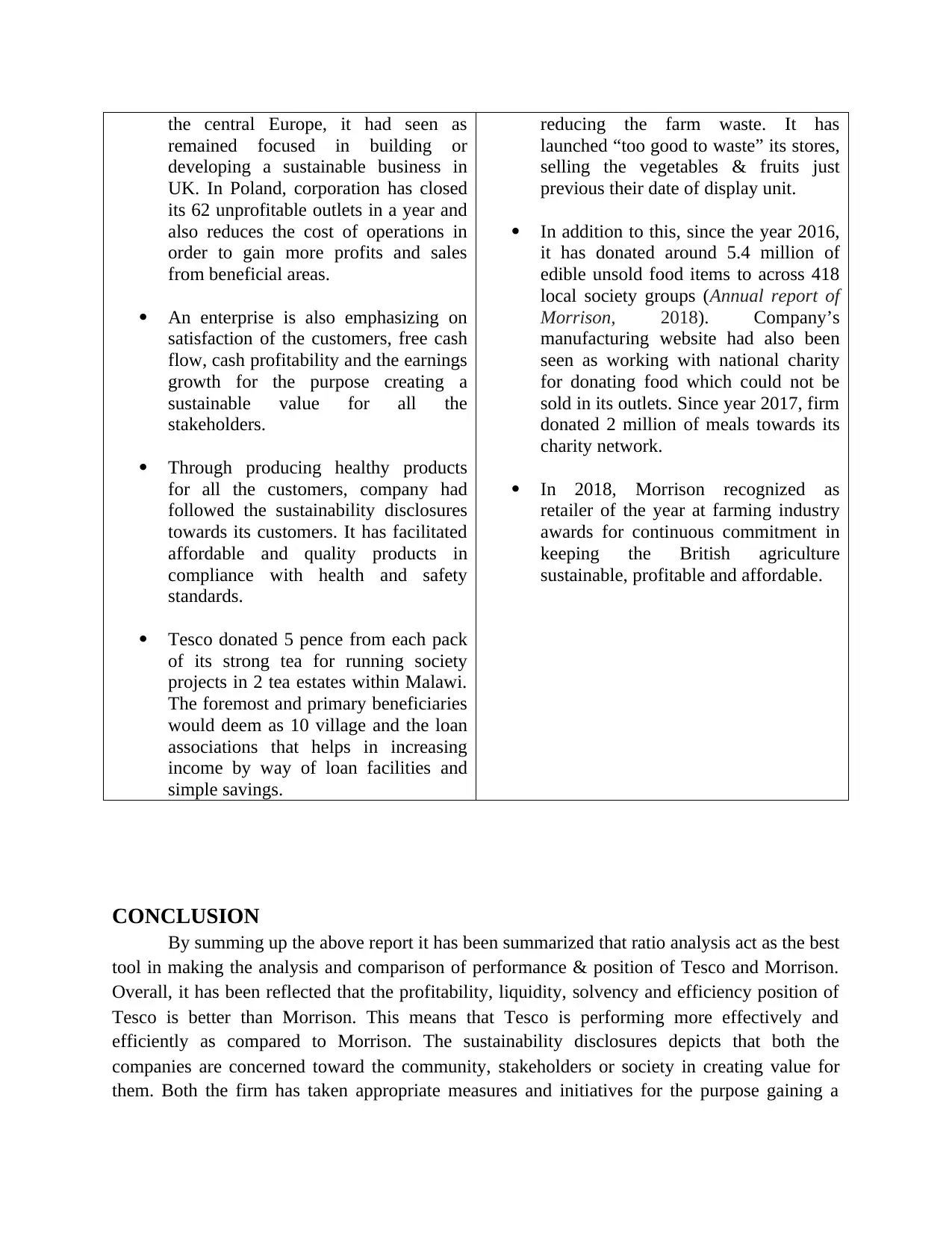
the central Europe, it had seen as
remained focused in building or
developing a sustainable business in
UK. In Poland, corporation has closed
its 62 unprofitable outlets in a year and
also reduces the cost of operations in
order to gain more profits and sales
from beneficial areas.
An enterprise is also emphasizing on
satisfaction of the customers, free cash
flow, cash profitability and the earnings
growth for the purpose creating a
sustainable value for all the
stakeholders.
Through producing healthy products
for all the customers, company had
followed the sustainability disclosures
towards its customers. It has facilitated
affordable and quality products in
compliance with health and safety
standards.
Tesco donated 5 pence from each pack
of its strong tea for running society
projects in 2 tea estates within Malawi.
The foremost and primary beneficiaries
would deem as 10 village and the loan
associations that helps in increasing
income by way of loan facilities and
simple savings.
reducing the farm waste. It has
launched “too good to waste” its stores,
selling the vegetables & fruits just
previous their date of display unit.
In addition to this, since the year 2016,
it has donated around 5.4 million of
edible unsold food items to across 418
local society groups (Annual report of
Morrison, 2018). Company’s
manufacturing website had also been
seen as working with national charity
for donating food which could not be
sold in its outlets. Since year 2017, firm
donated 2 million of meals towards its
charity network.
In 2018, Morrison recognized as
retailer of the year at farming industry
awards for continuous commitment in
keeping the British agriculture
sustainable, profitable and affordable.
CONCLUSION
By summing up the above report it has been summarized that ratio analysis act as the best
tool in making the analysis and comparison of performance & position of Tesco and Morrison.
Overall, it has been reflected that the profitability, liquidity, solvency and efficiency position of
Tesco is better than Morrison. This means that Tesco is performing more effectively and
efficiently as compared to Morrison. The sustainability disclosures depicts that both the
companies are concerned toward the community, stakeholders or society in creating value for
them. Both the firm has taken appropriate measures and initiatives for the purpose gaining a
remained focused in building or
developing a sustainable business in
UK. In Poland, corporation has closed
its 62 unprofitable outlets in a year and
also reduces the cost of operations in
order to gain more profits and sales
from beneficial areas.
An enterprise is also emphasizing on
satisfaction of the customers, free cash
flow, cash profitability and the earnings
growth for the purpose creating a
sustainable value for all the
stakeholders.
Through producing healthy products
for all the customers, company had
followed the sustainability disclosures
towards its customers. It has facilitated
affordable and quality products in
compliance with health and safety
standards.
Tesco donated 5 pence from each pack
of its strong tea for running society
projects in 2 tea estates within Malawi.
The foremost and primary beneficiaries
would deem as 10 village and the loan
associations that helps in increasing
income by way of loan facilities and
simple savings.
reducing the farm waste. It has
launched “too good to waste” its stores,
selling the vegetables & fruits just
previous their date of display unit.
In addition to this, since the year 2016,
it has donated around 5.4 million of
edible unsold food items to across 418
local society groups (Annual report of
Morrison, 2018). Company’s
manufacturing website had also been
seen as working with national charity
for donating food which could not be
sold in its outlets. Since year 2017, firm
donated 2 million of meals towards its
charity network.
In 2018, Morrison recognized as
retailer of the year at farming industry
awards for continuous commitment in
keeping the British agriculture
sustainable, profitable and affordable.
CONCLUSION
By summing up the above report it has been summarized that ratio analysis act as the best
tool in making the analysis and comparison of performance & position of Tesco and Morrison.
Overall, it has been reflected that the profitability, liquidity, solvency and efficiency position of
Tesco is better than Morrison. This means that Tesco is performing more effectively and
efficiently as compared to Morrison. The sustainability disclosures depicts that both the
companies are concerned toward the community, stakeholders or society in creating value for
them. Both the firm has taken appropriate measures and initiatives for the purpose gaining a
Paraphrase This Document
Need a fresh take? Get an instant paraphrase of this document with our AI Paraphraser
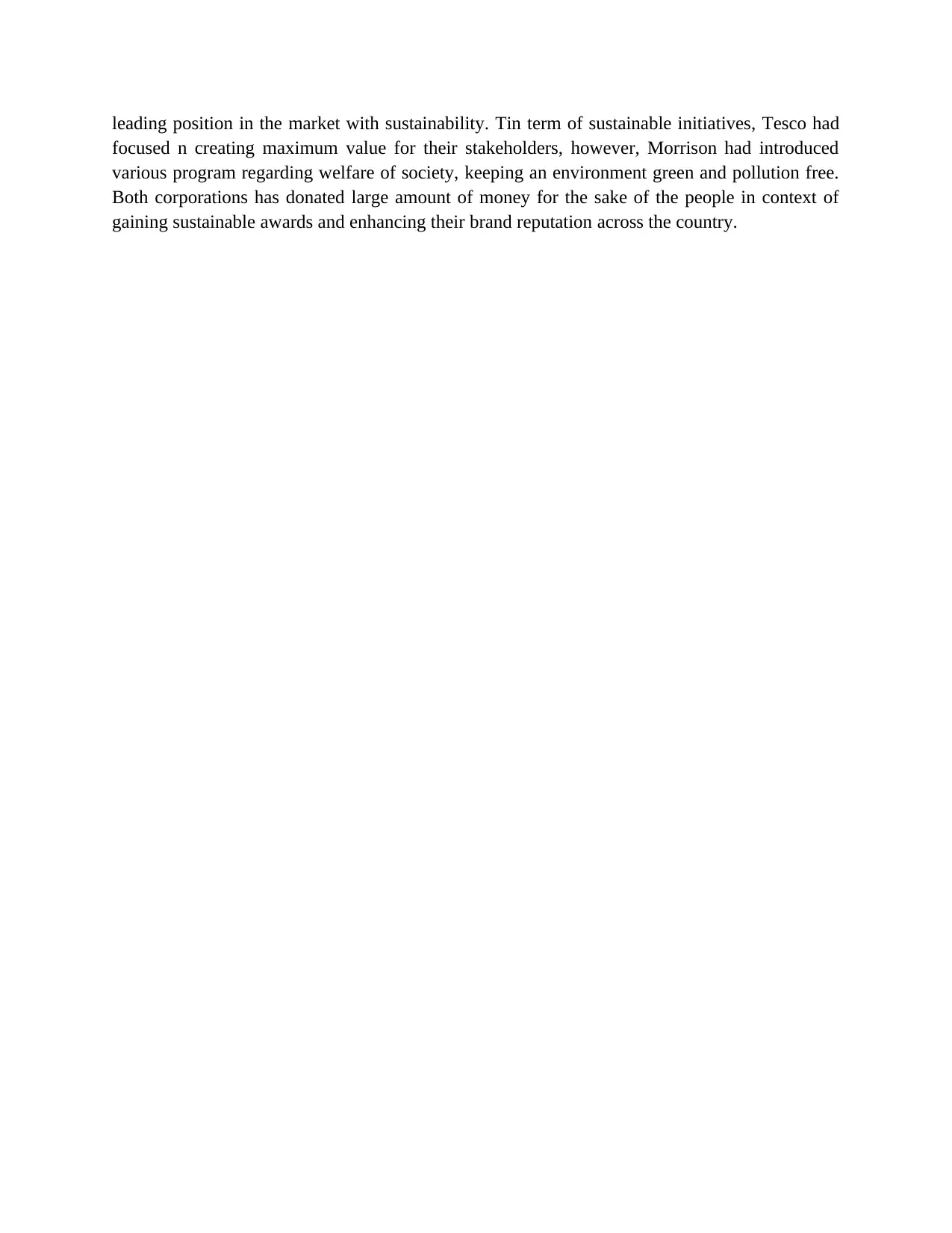
leading position in the market with sustainability. Tin term of sustainable initiatives, Tesco had
focused n creating maximum value for their stakeholders, however, Morrison had introduced
various program regarding welfare of society, keeping an environment green and pollution free.
Both corporations has donated large amount of money for the sake of the people in context of
gaining sustainable awards and enhancing their brand reputation across the country.
focused n creating maximum value for their stakeholders, however, Morrison had introduced
various program regarding welfare of society, keeping an environment green and pollution free.
Both corporations has donated large amount of money for the sake of the people in context of
gaining sustainable awards and enhancing their brand reputation across the country.
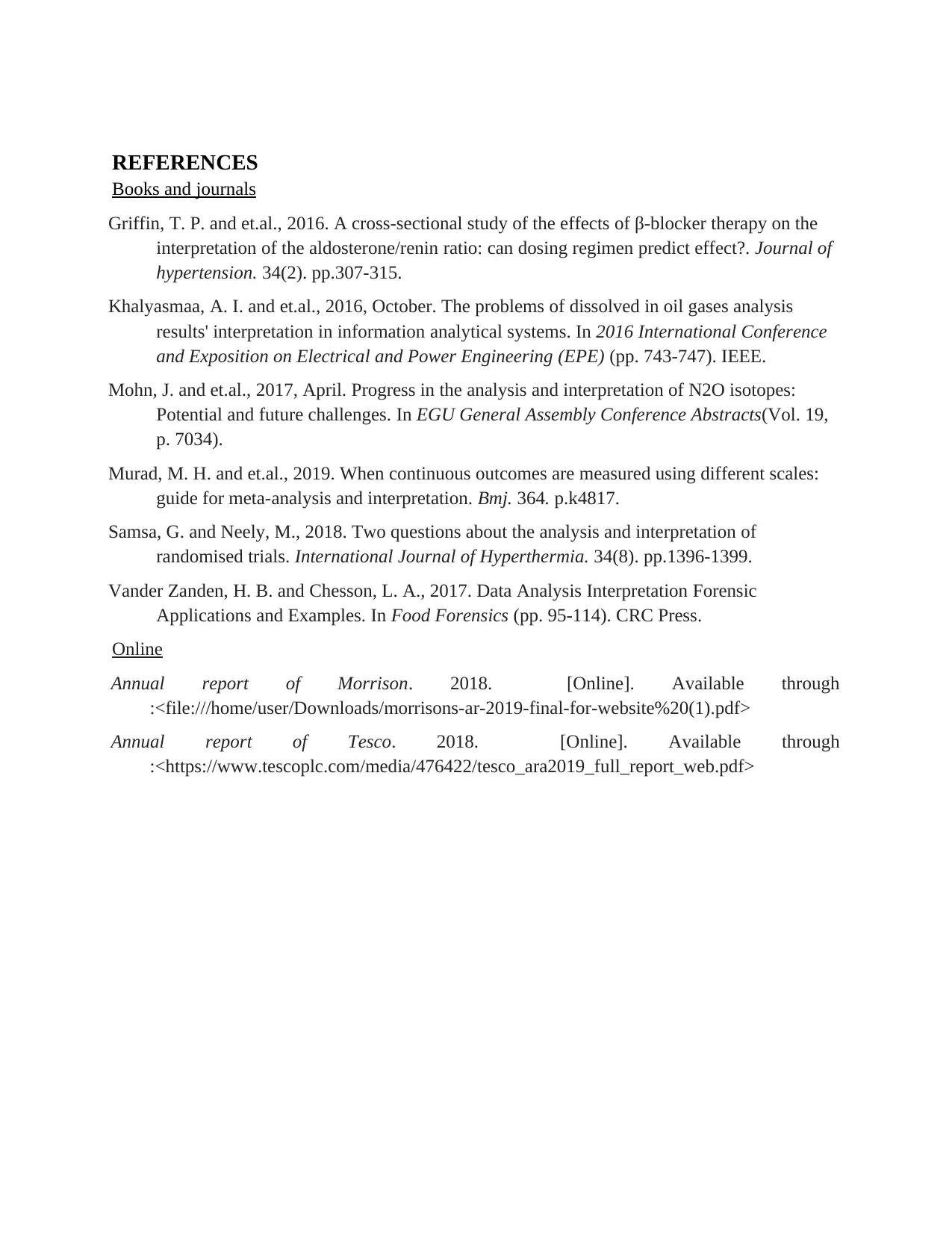
REFERENCES
Books and journals
Griffin, T. P. and et.al., 2016. A cross-sectional study of the effects of β-blocker therapy on the
interpretation of the aldosterone/renin ratio: can dosing regimen predict effect?. Journal of
hypertension. 34(2). pp.307-315.
Khalyasmaa, A. I. and et.al., 2016, October. The problems of dissolved in oil gases analysis
results' interpretation in information analytical systems. In 2016 International Conference
and Exposition on Electrical and Power Engineering (EPE) (pp. 743-747). IEEE.
Mohn, J. and et.al., 2017, April. Progress in the analysis and interpretation of N2O isotopes:
Potential and future challenges. In EGU General Assembly Conference Abstracts(Vol. 19,
p. 7034).
Murad, M. H. and et.al., 2019. When continuous outcomes are measured using different scales:
guide for meta-analysis and interpretation. Bmj. 364. p.k4817.
Samsa, G. and Neely, M., 2018. Two questions about the analysis and interpretation of
randomised trials. International Journal of Hyperthermia. 34(8). pp.1396-1399.
Vander Zanden, H. B. and Chesson, L. A., 2017. Data Analysis Interpretation Forensic
Applications and Examples. In Food Forensics (pp. 95-114). CRC Press.
Online
Annual report of Morrison. 2018. [Online]. Available through
:<file:///home/user/Downloads/morrisons-ar-2019-final-for-website%20(1).pdf>
Annual report of Tesco. 2018. [Online]. Available through
:<https://www.tescoplc.com/media/476422/tesco_ara2019_full_report_web.pdf>
Books and journals
Griffin, T. P. and et.al., 2016. A cross-sectional study of the effects of β-blocker therapy on the
interpretation of the aldosterone/renin ratio: can dosing regimen predict effect?. Journal of
hypertension. 34(2). pp.307-315.
Khalyasmaa, A. I. and et.al., 2016, October. The problems of dissolved in oil gases analysis
results' interpretation in information analytical systems. In 2016 International Conference
and Exposition on Electrical and Power Engineering (EPE) (pp. 743-747). IEEE.
Mohn, J. and et.al., 2017, April. Progress in the analysis and interpretation of N2O isotopes:
Potential and future challenges. In EGU General Assembly Conference Abstracts(Vol. 19,
p. 7034).
Murad, M. H. and et.al., 2019. When continuous outcomes are measured using different scales:
guide for meta-analysis and interpretation. Bmj. 364. p.k4817.
Samsa, G. and Neely, M., 2018. Two questions about the analysis and interpretation of
randomised trials. International Journal of Hyperthermia. 34(8). pp.1396-1399.
Vander Zanden, H. B. and Chesson, L. A., 2017. Data Analysis Interpretation Forensic
Applications and Examples. In Food Forensics (pp. 95-114). CRC Press.
Online
Annual report of Morrison. 2018. [Online]. Available through
:<file:///home/user/Downloads/morrisons-ar-2019-final-for-website%20(1).pdf>
Annual report of Tesco. 2018. [Online]. Available through
:<https://www.tescoplc.com/media/476422/tesco_ara2019_full_report_web.pdf>
⊘ This is a preview!⊘
Do you want full access?
Subscribe today to unlock all pages.

Trusted by 1+ million students worldwide
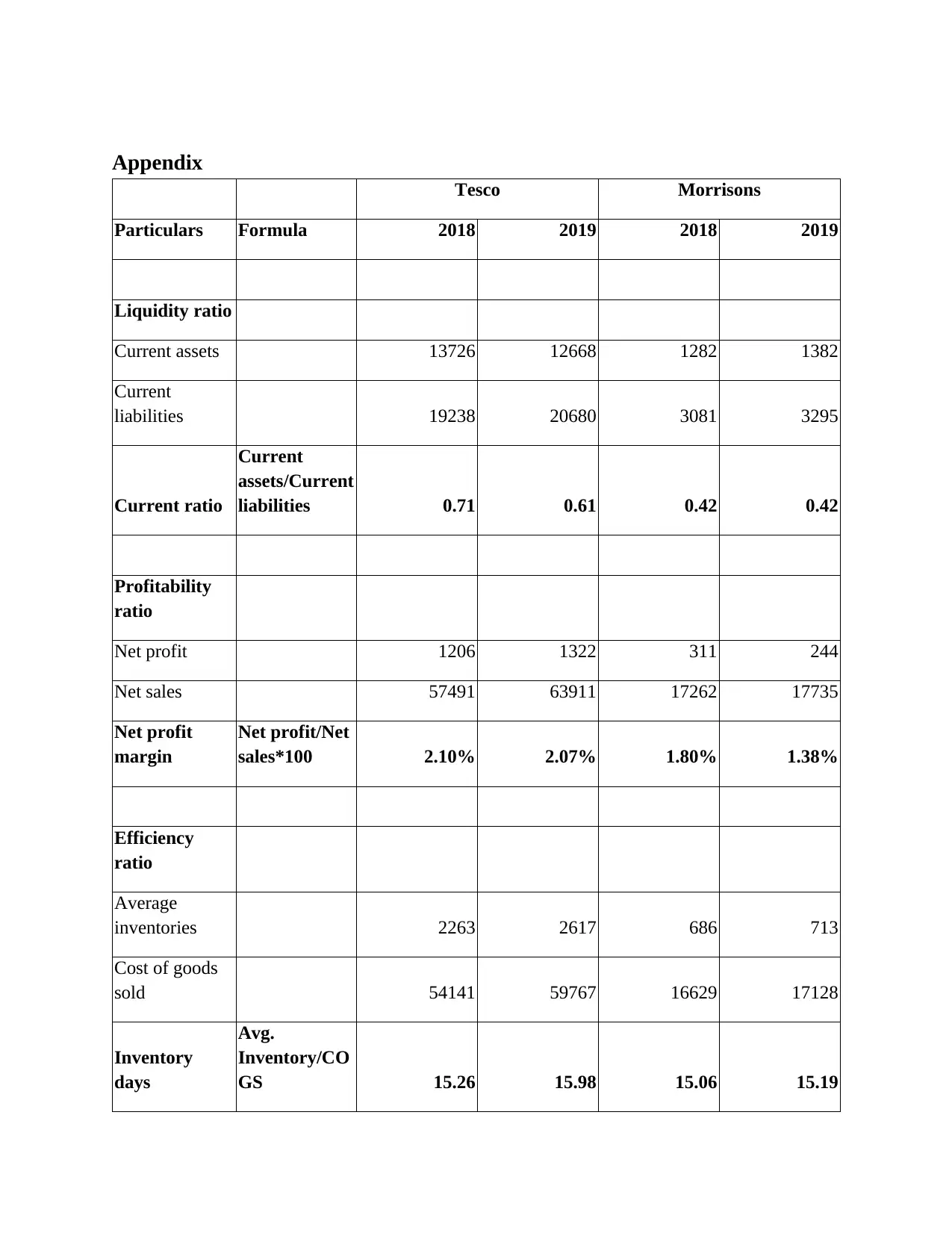
Appendix
Tesco Morrisons
Particulars Formula 2018 2019 2018 2019
Liquidity ratio
Current assets 13726 12668 1282 1382
Current
liabilities 19238 20680 3081 3295
Current ratio
Current
assets/Current
liabilities 0.71 0.61 0.42 0.42
Profitability
ratio
Net profit 1206 1322 311 244
Net sales 57491 63911 17262 17735
Net profit
margin
Net profit/Net
sales*100 2.10% 2.07% 1.80% 1.38%
Efficiency
ratio
Average
inventories 2263 2617 686 713
Cost of goods
sold 54141 59767 16629 17128
Inventory
days
Avg.
Inventory/CO
GS 15.26 15.98 15.06 15.19
Tesco Morrisons
Particulars Formula 2018 2019 2018 2019
Liquidity ratio
Current assets 13726 12668 1282 1382
Current
liabilities 19238 20680 3081 3295
Current ratio
Current
assets/Current
liabilities 0.71 0.61 0.42 0.42
Profitability
ratio
Net profit 1206 1322 311 244
Net sales 57491 63911 17262 17735
Net profit
margin
Net profit/Net
sales*100 2.10% 2.07% 1.80% 1.38%
Efficiency
ratio
Average
inventories 2263 2617 686 713
Cost of goods
sold 54141 59767 16629 17128
Inventory
days
Avg.
Inventory/CO
GS 15.26 15.98 15.06 15.19
Paraphrase This Document
Need a fresh take? Get an instant paraphrase of this document with our AI Paraphraser
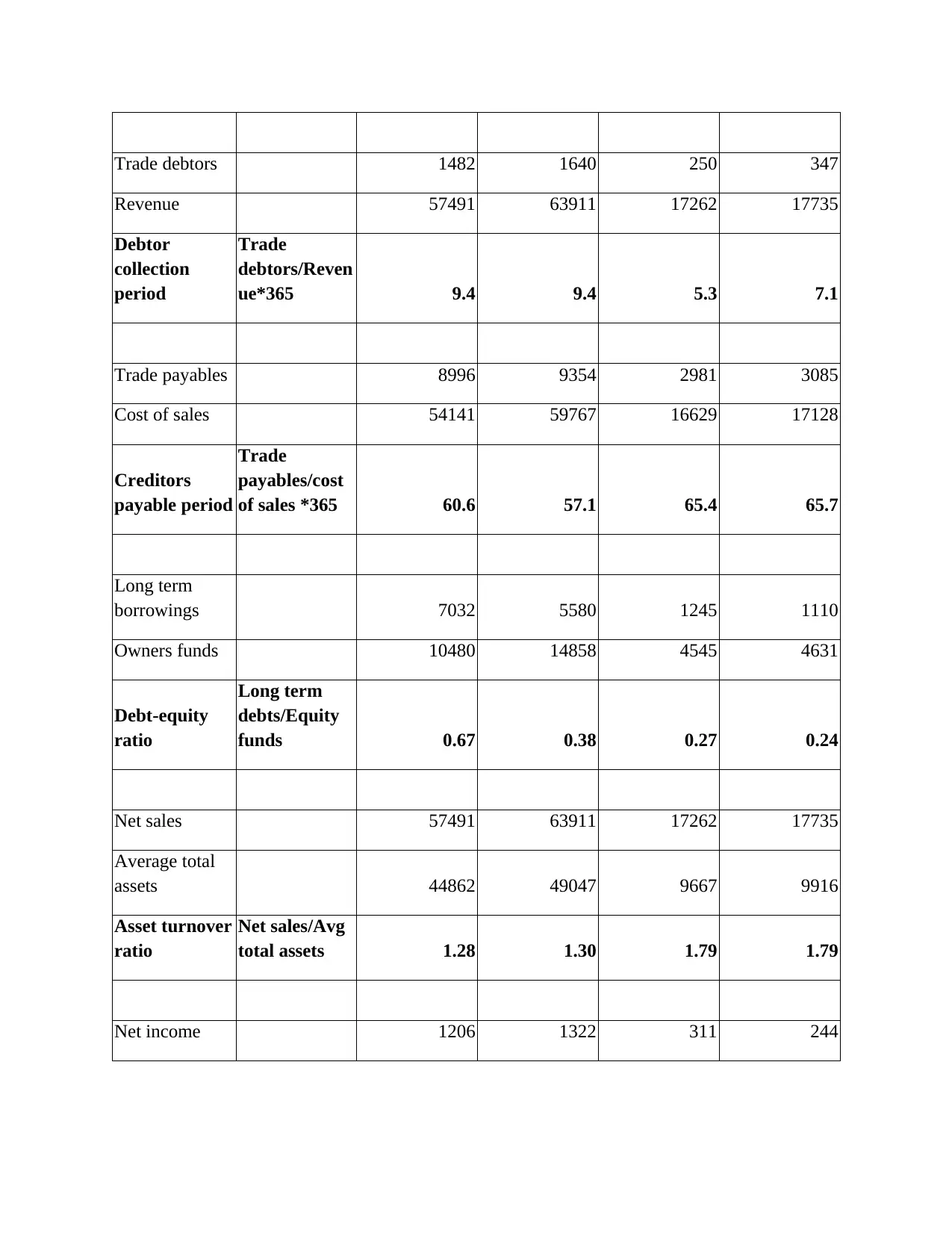
Trade debtors 1482 1640 250 347
Revenue 57491 63911 17262 17735
Debtor
collection
period
Trade
debtors/Reven
ue*365 9.4 9.4 5.3 7.1
Trade payables 8996 9354 2981 3085
Cost of sales 54141 59767 16629 17128
Creditors
payable period
Trade
payables/cost
of sales *365 60.6 57.1 65.4 65.7
Long term
borrowings 7032 5580 1245 1110
Owners funds 10480 14858 4545 4631
Debt-equity
ratio
Long term
debts/Equity
funds 0.67 0.38 0.27 0.24
Net sales 57491 63911 17262 17735
Average total
assets 44862 49047 9667 9916
Asset turnover
ratio
Net sales/Avg
total assets 1.28 1.30 1.79 1.79
Net income 1206 1322 311 244
Revenue 57491 63911 17262 17735
Debtor
collection
period
Trade
debtors/Reven
ue*365 9.4 9.4 5.3 7.1
Trade payables 8996 9354 2981 3085
Cost of sales 54141 59767 16629 17128
Creditors
payable period
Trade
payables/cost
of sales *365 60.6 57.1 65.4 65.7
Long term
borrowings 7032 5580 1245 1110
Owners funds 10480 14858 4545 4631
Debt-equity
ratio
Long term
debts/Equity
funds 0.67 0.38 0.27 0.24
Net sales 57491 63911 17262 17735
Average total
assets 44862 49047 9667 9916
Asset turnover
ratio
Net sales/Avg
total assets 1.28 1.30 1.79 1.79
Net income 1206 1322 311 244

Shareholders
funds 10480 14858 4545 4631
Return on
equity
Net
income/Share
holders funds 0.12 0.09 0.07 0.05
Gross profit 4144 3352 633 607
Net sales 57491 63911 17262 17735
Gross profit
ratio
Gross
profit/net
sales*100 0.072 0.052 0.037 0.034
Current assets 13726 12668 1282 1382
Inventories 2617 2264 686 713
Quick assets
Current assets-
Inventories 11109 10404 596 669
Current
liabilities 19238 20680 3081 3295
Quick ratio
Quick
assets/Current
liabilities 0.58 0.50 0.19 0.20
funds 10480 14858 4545 4631
Return on
equity
Net
income/Share
holders funds 0.12 0.09 0.07 0.05
Gross profit 4144 3352 633 607
Net sales 57491 63911 17262 17735
Gross profit
ratio
Gross
profit/net
sales*100 0.072 0.052 0.037 0.034
Current assets 13726 12668 1282 1382
Inventories 2617 2264 686 713
Quick assets
Current assets-
Inventories 11109 10404 596 669
Current
liabilities 19238 20680 3081 3295
Quick ratio
Quick
assets/Current
liabilities 0.58 0.50 0.19 0.20
⊘ This is a preview!⊘
Do you want full access?
Subscribe today to unlock all pages.

Trusted by 1+ million students worldwide
1 out of 12
Related Documents
Your All-in-One AI-Powered Toolkit for Academic Success.
+13062052269
info@desklib.com
Available 24*7 on WhatsApp / Email
![[object Object]](/_next/static/media/star-bottom.7253800d.svg)
Unlock your academic potential
Copyright © 2020–2026 A2Z Services. All Rights Reserved. Developed and managed by ZUCOL.




